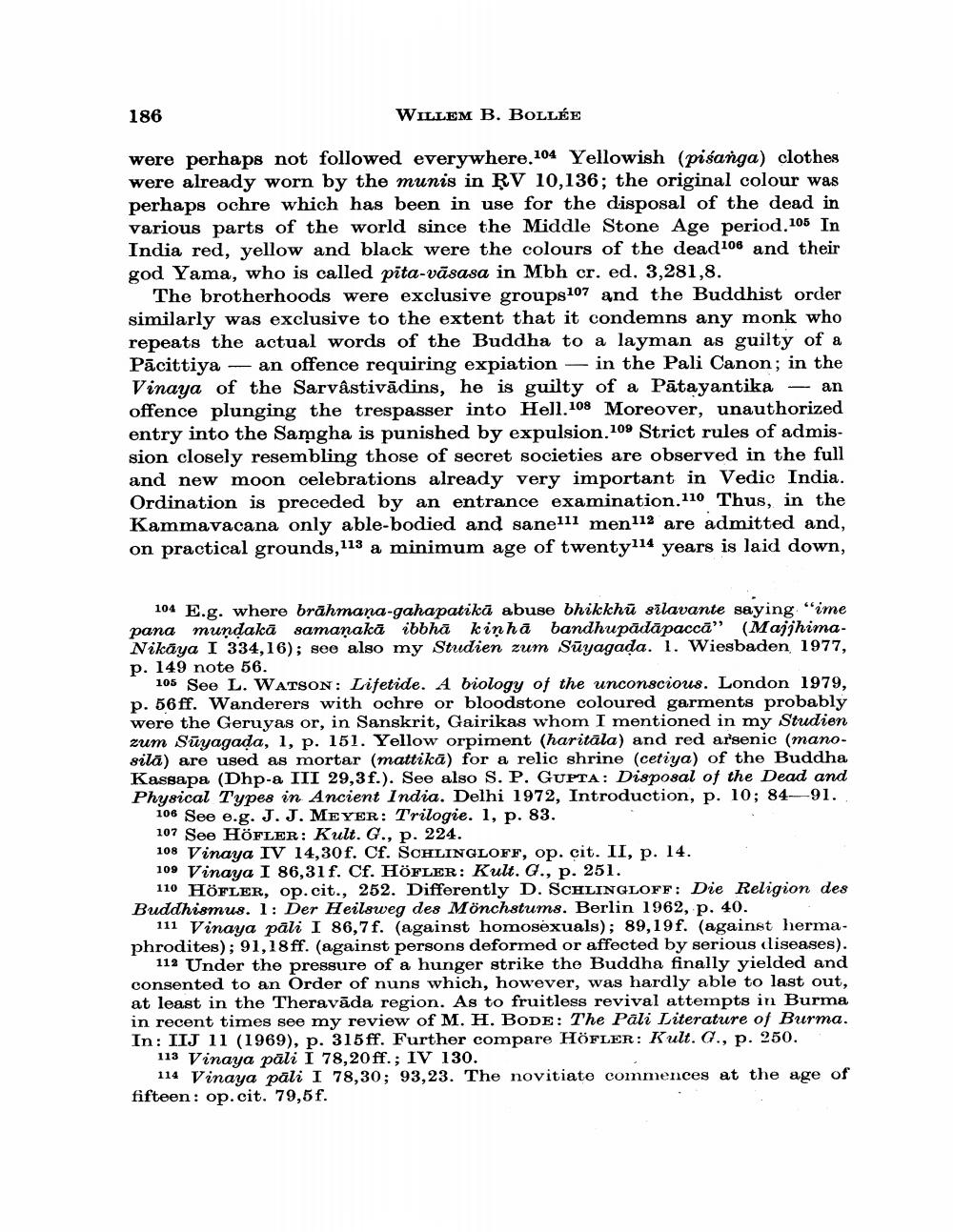________________
186
WILLEM B. BOLLÉE
were perhaps not followed everywhere. 104 Yellowish (pisanga) clothes were already worn by the munis in RV 10,136; the original colour was perhaps ochre which has been in use for the disposal of the dead in various parts of the world since the Middle Stone Age period.105 In India red, yellow and black were the colours of the dead 106 and their god Yama, who is called pita-vāsasa in Mbh cr. ed. 3,281,8.
The brotherhoods were exclusive groups 107 and the Buddhist order similarly was exclusive to the extent that it condemns any monk who repeats the actual words of the Buddha to a layman as guilty of a Pācittiya - an offence requiring expiation — in the Pali Canon; in the Vinaya of the Sarvâstivādins, he is guilty of a Pātayantika – an offence plunging the trespasser into Hell.108 Moreover, unauthorized entry into the Samgha is punished by expulsion 109 Strict rules of admission closely resembling those of secret societies are observed in the full and new moon celebrations already very important in Vedic India. Ordination is preceded by an entrance examination. 110 Thus, in the Kammavacana only able-bodied and sanelli men 112 are admitted and, on practical grounds, 113 a minimum age of twenty114 years is laid down,
104 E.g. where brahmana-gahapatikā abuse bhikkhū silavante saying "ime pana mundakā samanaka ibbhā kinha bandhupādāpaccā" (MajjhimaNikāya I 334,16); see also my Studien zum Sūyagada. 1. Wiesbaden 1977, p. 149 note 56.
105 See L. WATSON: Lifetide. A biology of the unconscious. London 1979, p. 56 ff. Wanderers with ochre or bloodstone coloured garments probably were the Geruyas or, in Sanskrit, Gairikas whom I mentioned in my Studien zum Sūyagada, 1, p. 151. Yellow orpiment (haritala) and red arsenic (manosila) are used as mortar (mattikā) for a relic shrine (cetiya) of the Buddha Kassapa (Dhp-a III 29,3f.). See also S. P. GUPTA: Disposal of the Dead and Physical Types in Ancient India. Delhi 1972, Introduction, p. 10; 84-91.,
106 See e.g. J. J. MEYER: Trilogie. I, p. 83. 107 See HÖFLER: Kult. G., p. 224. 108 Vinaya IV 14,30f. Cf. SCHLINGLOFF, op. cit. II, p. 14. 109 Vinaya I 86,31 f. Cf. HÖFLER: Kult. G., p. 251.
110 HÖFLER, op. cit., 252. Differently D. SCHLINGLOFF: Die Religion des Buddhismus. 1: Der Heilsweg des Mönchstums. Berlin 1962, p. 40.
111 Vinaya pali I 86,7f. (against homosexuals); 89,19f. (against hermaphrodites); 91,18 ff. (against persons deformed or affected by serious cliseases).
112 Under the pressure of a hunger strike the Buddha finally yielded and consented to an Order of nuns which, however, was hardly able to last out, at least in the Theravāda region. As to fruitless revival attempts in Burma in recent times see my review of M. H. BODE: The Pali Literature of Burma. In: IIJ 11 (1969), p. 315 ff. Further compare HÖFLER: Kult. C., p. 250.
113 Vinaya pali I 78,20 ff.; IV 130.
114 Vinaya pali I 78,30; 93,23. The novitiate commences at the age of fifteen: op.cit. 79,5 f.




